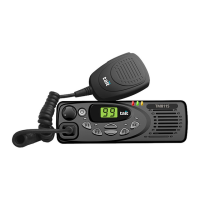TM8100/TM8200 Service Manual Transmitter Fault Finding (25W) 339
© Tait Electronics Limited June 2006
Task 9 —
Power and Current
Are Skewed
If the RF output power and the supply current are skewed, the output
matching is suspect.
1. Remove the
DIRC TOP can.
2. Remove the coupling capacitors C348, C349 and C350 —
see Figure 12.6.
3. Solder one terminal of a test capacitor to the PCB at the point shown
in Figure 12.6. Mount the capacitor vertically. Use a test capacitor
of the type GRM111, DLI C17, Murata 1210, or the equivalent.
The value of the capacitor depends on the frequency band of
the radio:
■ A4 — 100pF
■ B1, C0, D1 — 680pF
■ H5, H6 — 82pF.
4. Solder a 50Ω test lead to the PCB. Solder the outer sheath in the
position shown in Figure 12.6, and solder the central wire to the
other terminal of the test capacitor.
5. Connect the test lead to the test set.
6. Program the radio with the highest
frequency in the radio’s frequency
band: Enter the CCTM command 101 x x 0, where x is the frequency
in hertz.
7. Enter the CCTM command 33 to place the radio in transmit mode.
8. Note the RF output power measured by the test set, and note the
current reading on the DC power supply.
9. Enter the CCTM command 32 to place the radio in receive mode.
10. Program the radio with the centre
frequency in the band: Enter the
CCTM command 101 x x 0, where x is the frequency in hertz.
11. Repeat Step 7 to Step 9.
12. Program the radio with the lowest
frequency in the band: Enter the
CCTM command 101 x x 0, where x is the frequency in hertz.
13. Repeat Step 7 to Step 9.
14. If the power and current are still skewed, go to Ta s k 10
. If the power
and current are correct, remove the test lead and test capacitor,
resolder the coupling capacitors in position, and go to Ta sk 3 1
— the
PIN switch and LPF require checking.
RF output power: > 35W
current: < 8A (VHF), < 9A (UHF)

